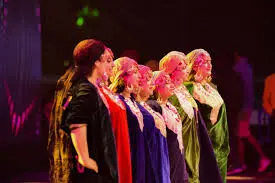Kashmir, often referred to as “Paradise on Earth,” is not only famous for its stunning landscapes but also for its rich cultural heritage, especially its mesmerizing music and dance. These elements are deeply intertwined with the region’s history and spirituality, offering a vibrant tapestry of sound and movement that reflects the essence of Kashmiri life.
Kashmiri music is renowned for its distinctive instruments and melodic structures. The Santoor, a hammered dulcimer, is one of the most celebrated instruments. Its delicate, resonant tones are created by striking strings with mallets, producing a sound that is both soothing and uplifting. The Rabab a lute-like string instrument, is another cornerstone of Kashmiri music, known for its deep, rich tones. Additionally, the Nagma, a type of drum and the Shehnai, a reed instrument, contribute rhythmic and melodic layers to traditional performances.
Kashmiri folk music is characterized by its lyrical themes, which often include nature, love and daily life. One prominent form is the Bhand Pather, a traditional performance that combines music, dance and satire. This unique theatrical form serves not only as entertainment but also as a medium for social commentary, reflecting the community’s values and issues.
The influence of Sufism on Kashmiri music is profound and enduring. Sufi music, with its spiritual and mystical qualities, has significantly shaped the musical landscape of the region. Songs like the Khandar or Kandari Khandar are examples of Sufi devotional music that express deep longing for the divine and a quest for spiritual connection. The melodies of these songs are designed to evoke a sense of transcendence and inner peace, embodying the mystical traditions of Sufism.
Dance in Kashmir is as diverse and expressive as its music. The Rauf dance is one of the most popular traditional dances, performed during festive occasions and celebrations. Dancers, often dressed in vibrant traditional attire, perform rhythmic movements accompanied by the beat of drums and the melodies of folk music. The Rauf is characterized by its graceful and lively steps, reflecting the joy and spirit of the community. Another significant dance form is the Wuchhun, performed during religious and cultural events. This dance is noted for its intricate footwork and the symbolic movements that narrate tales from Kashmiri folklore and history. The Wuchhun often involves elaborate costumes and is accompanied by traditional musical instruments, creating a visual and auditory feast.
In contemporary times, Kashmiri music and dance have evolved to incorporate various influences while retaining their traditional essence. Classical forms such as Hindustani classical music have blended with traditional Kashmiri styles, resulting in a unique fusion that resonates with modern audiences. Similarly, contemporary dance performances often blend traditional movements with modern choreography, creating dynamic and innovative presentations.
Artists and performers from Kashmir continue to gain recognition on national and international stages, showcasing the region’s rich cultural heritage to a broader audience. This exposure has led to a renewed interest in traditional Kashmiri music and dance, contributing to their preservation and evolution.
The preservation of Kashmiri music and dance is crucial for maintaining the cultural heritage of the region. Efforts by cultural organizations, institutions and local communities to document, teach and promote these art forms play a vital role in ensuring their continuity. Festivals, workshops and performances are key to keeping these traditions alive and engaging younger generations.
The music and dance of Kashmir form an enchanting blend of tradition, spirituality and artistic expression. From the mesmerizing sounds of the santoor and rabab to the vibrant movements of traditional dances, Kashmiri cultural expressions offer a rich and immersive experience. As efforts to celebrate and preserve these art forms continue, the mesmerizing music and dance of Kashmir will undoubtedly continue to captivate and inspire, bridging the past and present in a harmonious cultural symphony


